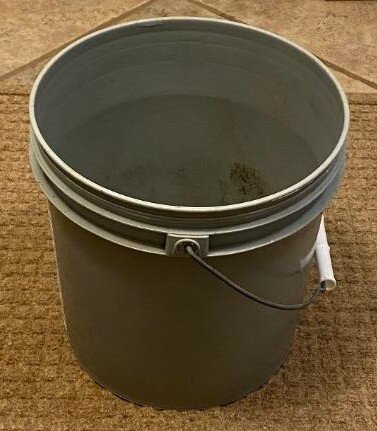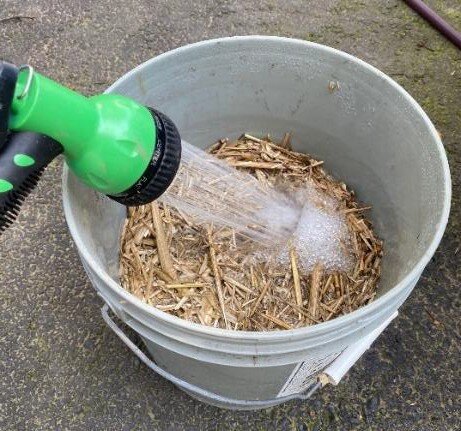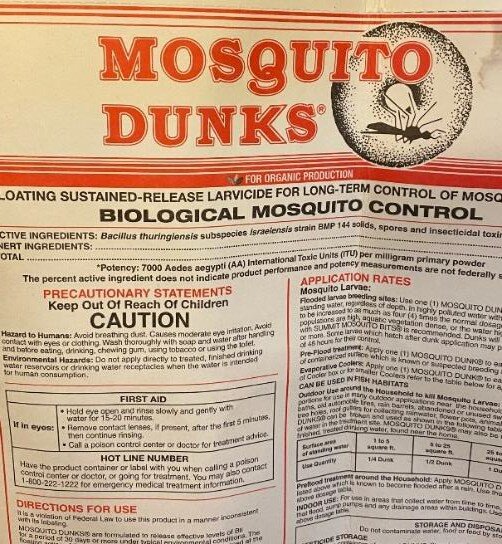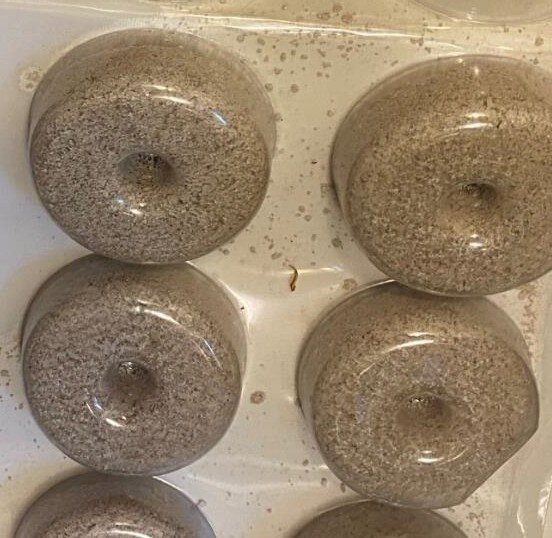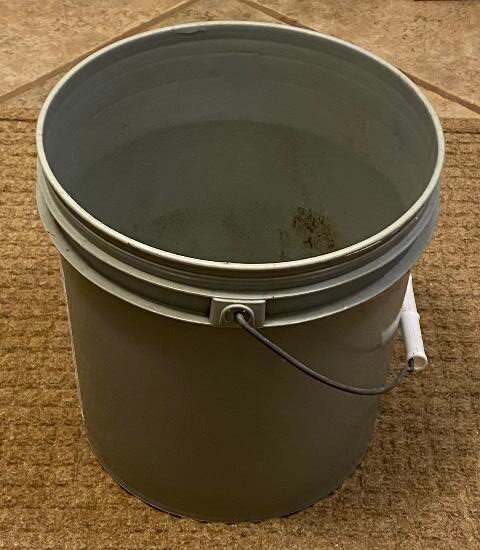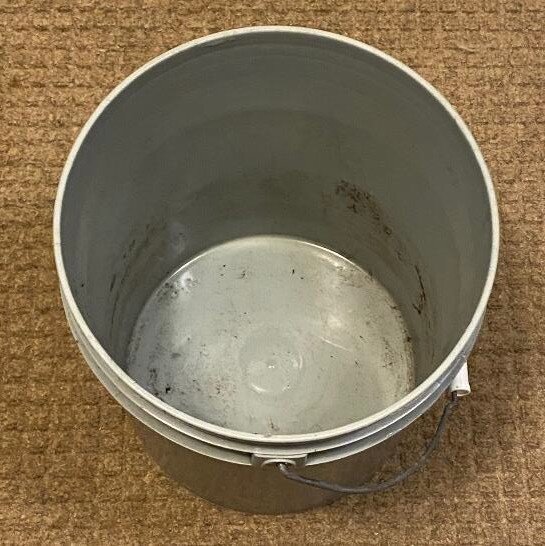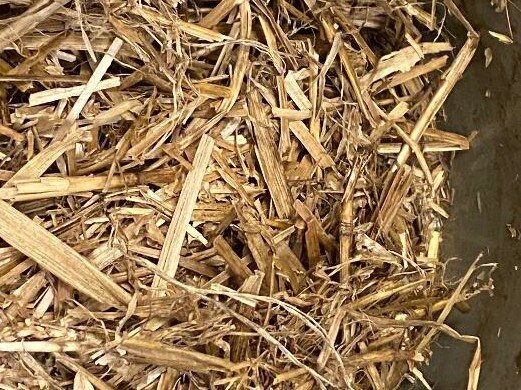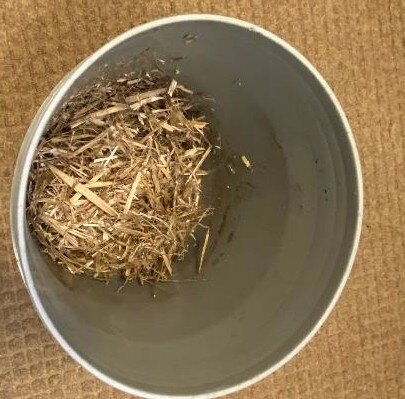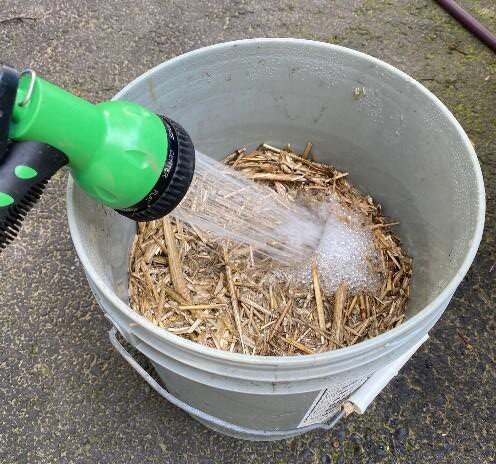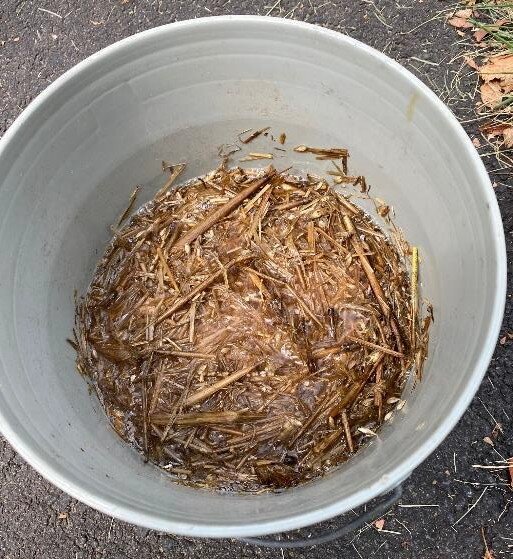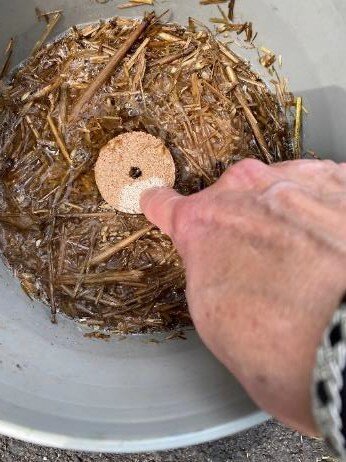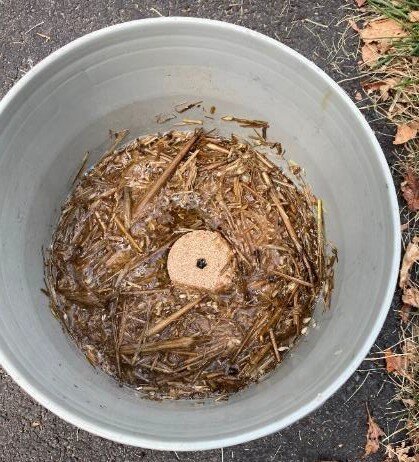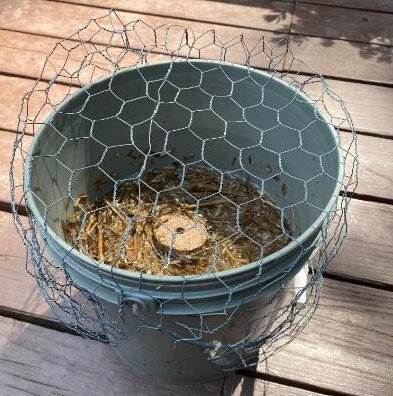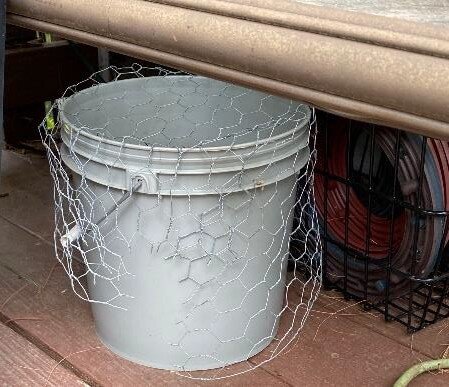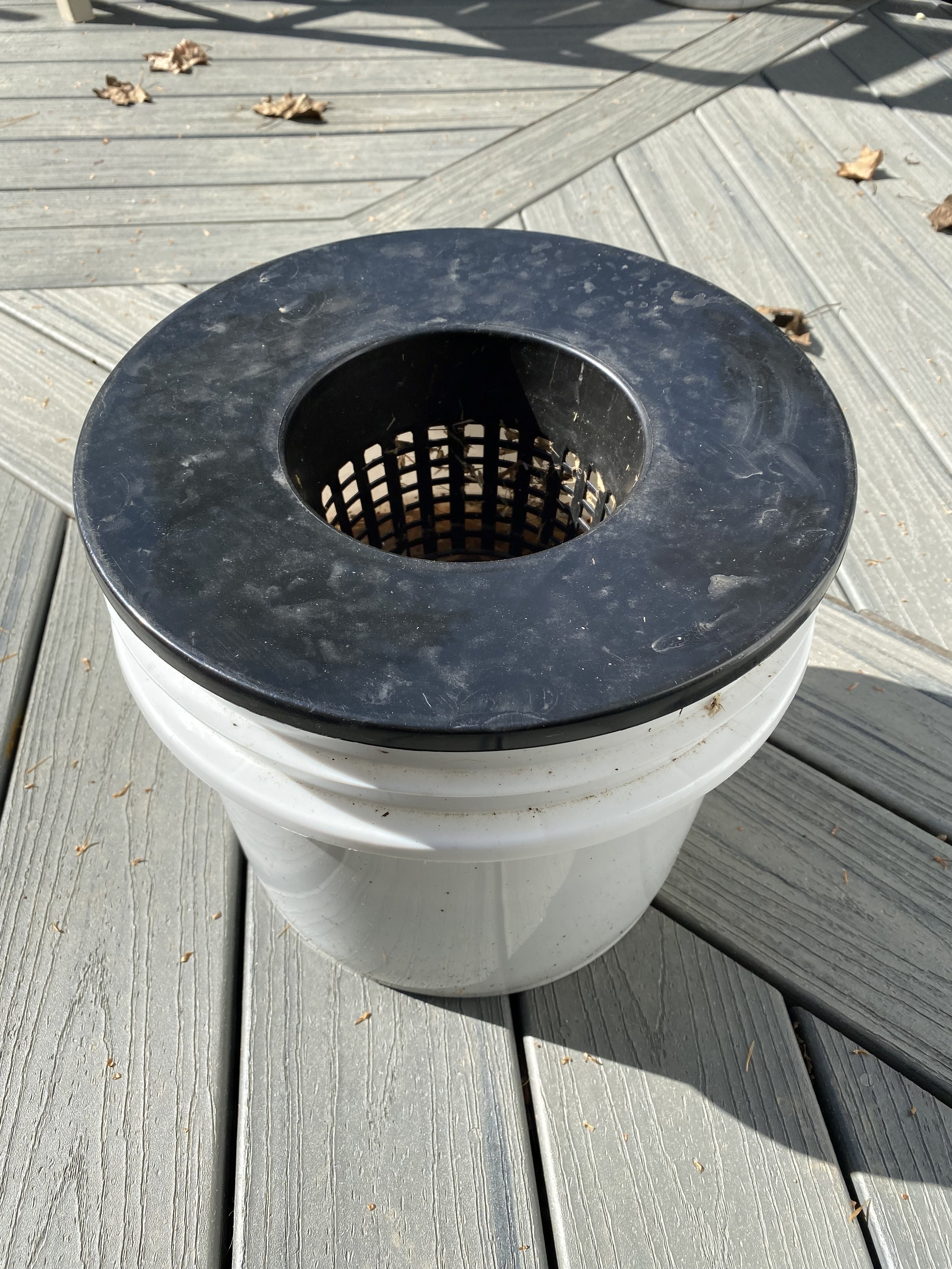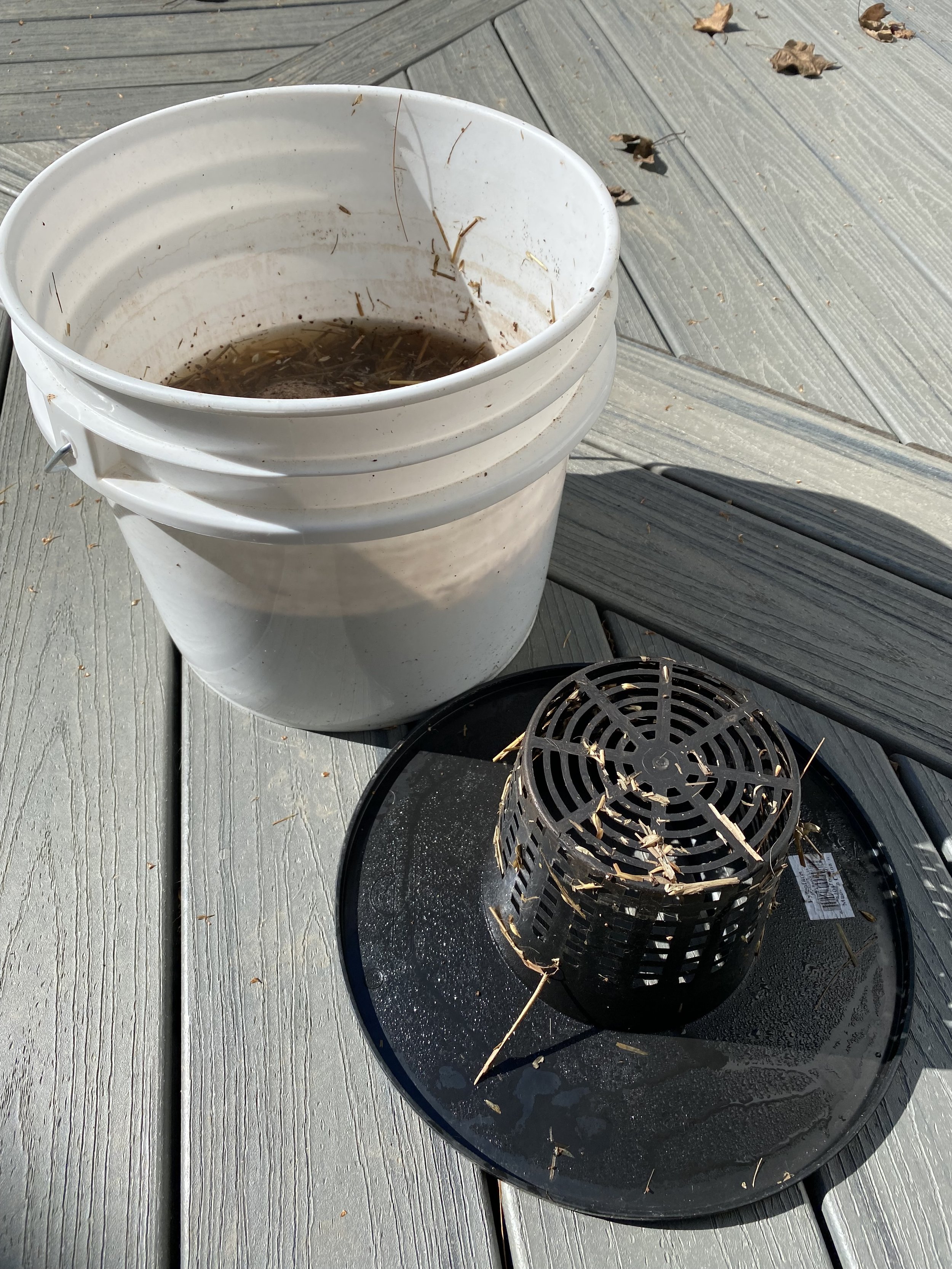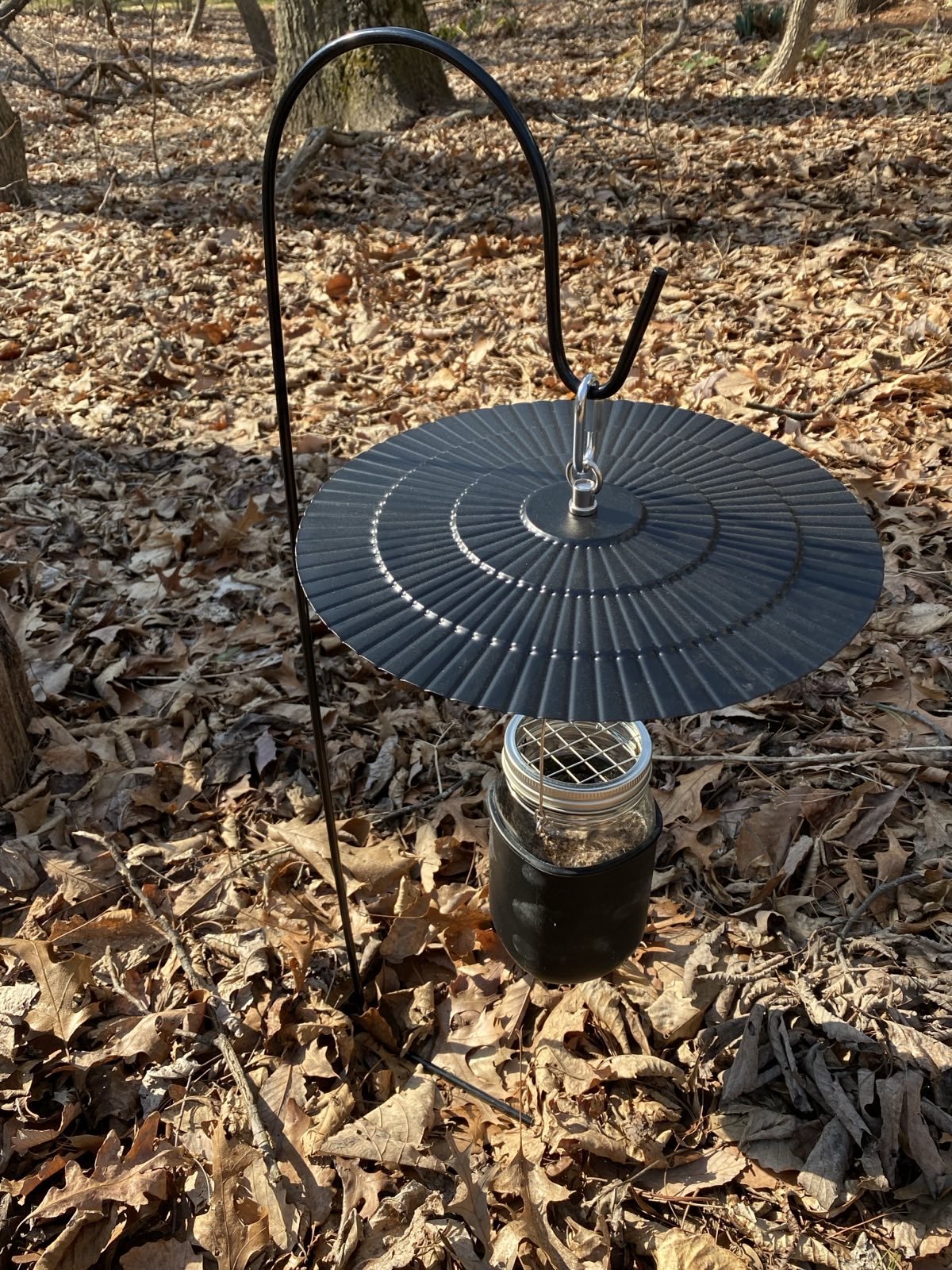Photo: Mosquito larvae traps, Jill Spohn
August 28, 2021 (Updated June 4, 2025)
Jill Spohn
Douglas W. Tallamy, an entomologist at the University of Delaware and author, suggests controlling mosquitoes at the larval stage instead of the adult stage. As he says in his book, Nature’s Best Hope, page 210:
Oppose mindless mosquito spraying by your township or HOA. Contrary to what the fogger operator may have told you, the pyrethroid-based insecticides used by mosquito foggers indiscriminately kill all insects, not just the mosquitos. Ironically, targeting adult mosquitos is the worst and by far the most expensive approach to mosquito control, because mosquitos are best controlled in the larval stage. Put a five-gallon bucket of water in a sunny place in your yard and add a handful of hay or straw. After a few days, the resulting brew is irresistible to gravid (egg-filled) female mosquitos. After the mosquitos have laid their eggs, add a commercially available mosquito dunk tablet that contains Bacillus thuringiensis (Bt), a natural larvicide, to your bucket. The eggs will hatch and the larvae will die. This way, you control mosquitos, and only mosquitos, without the use of harmful insecticides.
Insects are at the base of the food chain and, without them, birds and other creatures are challenged to find enough food for themselves and their young. When they eat sprayed insects, the insecticide can build up and affect their health and the insecticide remains in soil and water. Based on NVBA Wildlife Sanctuary Program research, it is clear to us that fogging chemicals are bad for our environment and critters. Our To Spray, or Not To Spray brochure summarizes that research.
There is an effective alternative to harmful mosquito spraying – reducing standing water on your property and building mosquito larvae traps. The most effective control of mosquito populations is at the larval stage, not the adult stage of their life cycle. The University of Maryland Extension provides advice on mosquito life cycle and control at home here. Note that you must eliminate standing water and monitor; here is a good checklist from Montgomery County.
A mosquito larvae trap works because adult mosquitoes are drawn to a fermenting solution and lay their eggs. An added Mosquito Dunk®, or similar product that releases a selective bacterium, affects only the mosquito larvae. Do NOT use Mosquito Bits® (they are quick kill and do not have the slow release that you need).
I have tried this Do-It-Yourself (DIY) method at home in Northern Virginia and in Maine and have seen an impressive lack of mosquitoes and pleasant times outdoors. Dr. Tallamy reviewed these instructions and we have updated them based on his feedback and our own and others’ experience below.
There are also commercially-available traps listed below.
How to Make Your Own Mosquito Larvae Trap: Instructions for the Original Bucket Trap
What you need:
Bucket
Straw or Hay - Dried; or Dried Leaves or grass (not freshly-picked green grass or leaves)
Water – funky water from a rain barrel would also work, says Tallamy
Mosquito Dunk® or another brand containing Bacillus thuringiensis (Bti) - for a surface area under 5 square feet, use at least a 1/4 of a Dunk
Chicken Wire or similar screening – or critter escape ramp (such as a stick).
1. Use an empty bucket.
2. Add dried organic matter to the bucket. I used 3 or 4 handfuls here – 3 or 4 cups. I use hay in these photos.
3. Add water to the bucket. I fill the bucket up halfway. My ratio of hay to water is about 1 to 4.
4. Allow the water and organic matter to ferment for a few days. I usually let it sit for 3 days but if it’s hot, you probably need less time. (Add a cover or a critter escape ramp.)
5. After 3 days, the mixture has fermented. Add the Mosquito Dunk®. Summit Chemicals recommends at least a 1/4 of a Dunk for under 5 square feet of water surface area.
Place Mosquito Dunk® in the bucket on top of the fermenting solution. Dr. Tallamy may know when a mosquito has laid eggs, but I don’t. I place the Mosquito Dunk® in right before I set the trap.
6. Cover the bucket with chicken wire or similar screening that allows adult mosquitos into the solution, but keeps other critters out. Be careful of the sharp points on the chicken wire. Some people use sticks that can be placed in the bucket to be used as an escape ramp for critters.
7. Set in place. Dr. Tallamy recommends a sunny spot but I have placed it in dappled shade with good results. The Mosquito Dunk® lasts for about a month and I replace the solution after about 3 or 4 weeks.
I try to put the traps away from where we have had mosquito issues and keep them out of the way of our dogs. They should be out of the reach of children as well. Based on feedback and experience, I have moved the buckets farther away from people; for example, underneath the deck rather than on the deck and at the edge of the woods rather than close to the patio. See the FAQs for additional placement information.
In recent testing, I feel that the traps in shady areas have more mosquito activity with eggs and larvae.
8. Monitor Occasionally. I have not drilled drainage holes in the side of our buckets, thus when we get significant rains, I will ensure that the buckets are not overflowing. I will drain out some water when they are too full. I have only needed to do this a few times over the years. See the Commercially Available Trap section for a Maintenance Tracking Sheet.
I hope you will give all non-insecticide mosquito control methods a try. They really work, and limiting insecticide use is critically important.
Jill’s Mosquito Larvae Trap - With Bucket and Hydroponic Lid
I have tried to improve the appearance of the mosquito traps I use at home. I found plain, white 3.5 gallon food-safe buckets (with handles) that I use with a black hydroponic growing lid (snaps on to secure in place). I got sets of 6 for our home. I use 2 underneath our deck, 2 at the edge of the woods, and 2 on either side of our covered porch. I use a lid to try to keep our dogs out of the solution and to make sure that chipmunks and such do not get trapped in the solution.
Here are photos:
Jill’s Mini Mosquito Larvae Trap
To create a smaller, more aesthetically pleasing larvae trap, I am using a quart size wide mouth mason jar as the base. I found a vase “frog” insert grid to allow mosquitoes to enter the trap and to keep critters out of the water. To hide the fermented water and add black (some research shows mosquitoes are attracted to black), I used a slide on cover. For covered areas, these are the essential pieces - plus, of course, the fermented water with dried organic material and a quarter of a Mosquito Dunk®. DO NOT use Mosquito Bits® - those are just for quick kill according to Summit Chemical; therefore, if you used the Bits, you have created a breeding spot for larvae to mature after the quick kill.
The best part is that the mason jar can be tossed into the dishwasher. Before cleaning, I pull out the Dunk and then dump the solution into a dry area in the yard. I remove the cover and the grid and hand wash.
Note that you must monitor to make sure there’s fermented water and replace the Mosquito Dunk® regularly. To help myself with the maintenance, I have created an Excel spreadsheet for tracking. Commercially available on my Etsy site (see below).
In areas that are exposed to the elements, I added a shepherd’s hook, bird feeder cover, mason jar hanger, and some hooks (to keep the glass jar in place).
Here are photos:
Frequently Asked Questions
Question: Could I use grass clippings or old leaves instead of straw or hay?
Laurie Tyler Dodd reports success using grass or dead leaves instead of hay.
G. Lambert reports that if you use grass or leaves, they need to be dried - not fresh green grass or leaves. (Reported after consulting with Doug Tallamy.)
Question: Can I remove the solid organic material once it’s started fermenting?
Doug Tallamy: I think the straw or hay needs to remain in the water to keep generating the attractive smells that bring in the female mosquitoes.
Question: My traps are 3 or 4 weeks old. Do I need to dump the solution and restart the trap? Or can I just add new mosquito dunks?
Doug Tallamy: I think you can just add some water to freshen it up a bit. Maybe throw in a few more leaves. Make sure there’s enough of the mosquito dunk.
Question: If I put the dunks in before fermenting will this decrease the dunks’ amount of chemicals due to chlorine affecting Bti?
Doug Tallamy: That's a waste of dunk. There are no mosquito eggs in there yet so why put the dunk in early. They don't last forever.
Question: Are there larvae traps that kill the females too?
Yes, passive mosquito traps can provide additional protection and they do not use pyrethroids. See links to commercial sources of such traps below.
Question: What do you recommend we do with the water that now has dead larvae, Bti, and old straw or hay in it? Can the spent dunk and straw/hay be composted?
Doug Tallamy: Sure. It is harmless
Question: Our property has a swamp area on it, that I cannot drain. Will the mosquito larvae traps still be effective in reducing the mosquitos somewhat or will the swamp take any benefit away?
Doug Tallamy: The reality is that the swamp will always make mosquitoes. Setting up larvae traps might reduce the population but whether that will be noticeable to someone sitting in the yard is hard to say. There is little to lose by trying, but that swamp area is a mosquito producing machine.
Summit Chemicals: The swamp/wetlands will always produce mosquitoes unless a State or County entity treats it effectively. It would be next to impossible for an individual to control.
Commercially Available Traps and Maintenance Tracker
Autocidal Gravid Ovitrap, developed by the Center for Disease Control and Prevention and marketed as the BioCare AGO.
Jill Spohn created the Mosquito Jill’s Etsy site to sell the mini traps shown above for those who desire the convenience of a kit. A maintenance tracking sheet is also available for download.


